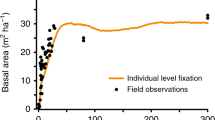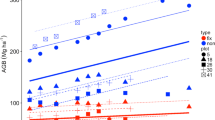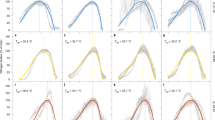Abstract
Recent observations suggest that the large carbon sink in mature and recovering forests may be strongly limited by nitrogen1,2,3. Nitrogen-fixing trees (fixers) in symbiosis with bacteria provide the main natural source of new nitrogen to tropical forests3,4. However, abundances of fixers are tightly constrained5,6,7, highlighting the fundamental unanswered question of what limits new nitrogen entering tropical ecosystems. Here we examine whether herbivory by animals is responsible for limiting symbiotic nitrogen fixation in tropical forests. We evaluate whether nitrogen-fixing trees experience more herbivory than other trees, whether herbivory carries a substantial carbon cost, and whether high herbivory is a result of herbivores targeting the nitrogen-rich leaves of fixers8,9. We analysed 1,626 leaves from 350 seedlings of 43 tropical tree species in Panama and found that: (1) although herbivory reduces the growth and survival of all seedlings, nitrogen-fixing trees undergo 26% more herbivory than non-fixers; (2) fixers have 34% higher carbon opportunity costs owing to herbivory than non-fixers, exceeding the metabolic cost of fixing nitrogen; and (3) the high herbivory of fixers is not driven by high leaf nitrogen. Our findings reveal that herbivory may be sufficient to limit tropical symbiotic nitrogen fixation and could constrain its role in alleviating nitrogen limitation on the tropical carbon sink.
This is a preview of subscription content, access via your institution
Access options
Access Nature and 54 other Nature Portfolio journals
Get Nature+, our best-value online-access subscription
$29.99 / 30 days
cancel any time
Subscribe to this journal
Receive 51 print issues and online access
$199.00 per year
only $3.90 per issue
Buy this article
- Purchase on Springer Link
- Instant access to full article PDF
Prices may be subject to local taxes which are calculated during checkout



Similar content being viewed by others
Data availability
The datasets generated during and/or analysed during the current study are available at the NERC Environmental Information Data Centre repository at https://doi.org/10.5285/67c95112-edee-435f-9355-9d8bab3a5634. Source data are provided with this paper.
References
Fernández-Martínez, M. et al. Nutrient availability as the key regulator of global forest carbon balance. Nat. Clim. Chang. 4, 471–476 (2014).
Wright, S. J. Plant responses to nutrient addition experiments conducted in tropical forests. Ecol. Monogr. 89, e01382 (2019).
Levy-Varon, J. H. et al. Tropical carbon sink accelerated by symbiotic dinitrogen fixation. Nat. Commun. 10, 5637 (2019).
Batterman, S. A. et al. Key role of symbiotic dinitrogen fixation in tropical forest secondary succession. Nature 502, 224–227 (2013).
Ter Steege, H. et al. Continental-scale patterns of canopy tree composition and function across Amazonia. Nature 443, 444–447 (2006).
Hedin, L. O., Brookshire, E. N. J., Menge, D. N. L. & Barron, A. R. The nitrogen paradox in tropical forest ecosystems. Annu. Rev. Ecol. Evol. Syst. 40, 613–635 (2009).
Menge, D. N. L. et al. Patterns of nitrogen-fixing tree abundance in forests across Asia and America. J. Ecol. 107, 2598–2610 (2019).
Matson, W. J.Jr Herbivory in relation to plant nitrogen content. Annu. Rev. Ecol. Syst. 11, 119–161 (1980).
Coley, P. D., Bateman, M. L. & Kusar, T. A. The effects of plant quality on caterpillar growth and defense against natural enemies. Oikos 115, 219–228 (2006).
Wieder, W. R., Cleveland, C. C., Smith, W. K. & Todd-Brown, K. Future productivity and carbon storage limited by terrestrial nutrient availability. Nat. Geosci. 8, 441–444 (2015).
Barron, A. R., Purves, D. W. & Hedin, L. O. Facultative nitrogen fixation by canopy legumes in a lowland tropical forest. Oecologia 165, 511–520 (2011).
McCulloch, L. A. & Porder, S. Light fuels while nitrogen suppresses symbiotic nitrogen fixation hotspots in neotropical canopy gap seedlings. New Phytol. 231, 1734–1745 (2021).
Brookshire, E. N. J. et al. Symbiotic N fixation is sufficient to support net aboveground biomass accumulation in a humid tropical forest. Sci Rep. 9, 7571 (2019).
Gei, M. et al. Legume abundance along successional and rainfall gradients in Neotropical forests. Nat. Ecol. Evol. 2, 1104–1111 (2018).
Vance, C. P. in Nitrogen-fixing Leguminous Symbioses. Nitrogen Fixation: Origins, Applications, and Research Progress, Vol. 7 (eds Dilworth, M. J. et al.) (Springer, 2008).
Vitousek, P. M. & Howarth, R. W. Nitrogen limitation on land and in the sea: how can it occur? Biogeochemistry 13, 87–115 (1991).
Menge, D. N. L., Levin, S. A. & Hedin, L. O. Evolutionary tradeoffs can select against nitrogen fixation and thereby maintain nitrogen limitation. Proc. Natl Acad. Sci. USA 105, 1573–1578 (2008).
Sheffer, E., Batterman, S. A., Levin, S. A. & Hedin, L. O. Biome-scale nitrogen fixation strategies selected by climatic constraints on nitrogen cycle. Nat. Plants 1, 15182 (2015).
Vitousek, P. M. & Field, C. B. Ecosystem constraints to symbiotic nitrogen fixers: a simple model and its implications. Biogeochemistry 46, 179–202 (1999).
Coley, P. D. & Barone, J. A. Herbivory and plant defenses in tropical forests. Annu. Rev. Ecol. Syst. 27, 305–335 (1996).
Fyllas, N. M. et al. Basin-wide variations in foliar properties of Amazonian forest: phylogeny, soils and climate. Biogeosciences 6, 2677–2708 (2009).
Batterman, S. A. et al. Phosphatase activity and nitrogen fixation reflect species differences, not nutrient trading or nutrient balance, across tropical rainforest trees. Ecol. Lett. 21, 1486–1495 (2018).
Menge, D. N. L., Wolf, A. A. & Funk, J. L. Diversity of nitrogen fixation strategies in Mediterranean legumes. Nat. Plants 1, 15064 (2015).
Ritchie, M. E. & Tilman, D. Responses of legumes to herbivores and nutrients during succession on a nitrogen-poor soil. Ecol. Soc. Am. 76, 2648–2655 (1995).
Taylor, B. N. & Ostrowsky, L. R. Nitrogen-fixing and non-fixing trees differ in leaf chemistry and defence but not herbivory in a lowland Costa Rican rain forest. J. Trop. Ecol. 35, 270–279 (2019).
Endara, M.-J. et al. Coevolutionary arms race versus host defense chase in a tropical herbivore–plant system. Proc. Natl Acad. Sci. USA 114, E7499–E7505 (2017).
Kursar, T. A. & Coley, P. D. Convergence in defense syndromes of young leaves in tropical rainforests. Biochem. Syst. Ecol. 31, 929–949 (2003).
Kursar, T. A. et al. The evolution of antiherbivore defenses and their contribution to species coexistence in the tropical tree genus Inga. Proc. Natl Acad. Sci. USA 106, 18073–18078 (2009).
Taylor, B. N. & Menge, D. N. L. Light regulates tropical symbiotic nitrogen fixation more strongly than soil nitrogen. Nat. Plants 4, 655–661 (2018).
Adams, M., Turnbull, T., Sprent, J. & Buchmann, N. Legumes are different: leaf nitrogen, photosynthesis, and water use efficiency. Proc. Natl Acad. Sci. USA 113, 4098–4103 (2016).
Coley, P. D. Effects of plant growth rate and leaf lifetime on the amount and type of anti-herbivore defense. Oecologia 74, 531–536 (1988).
Batterman, S. A., Wurzburger, N. & Hedin, L. O. Nitrogen and phosphorus interact to control tropical symbiotic N2 fixation: a test in Inga punctata. J. Ecol. 101, 1400–1408 (2013).
Eichhorn, M. P., Nilus, R., Compton, S. G., Hartley, S. E. & Burslem, D. F. R. P. Herbivory of tropical rain forest tree seedlings correlates with future mortality. Ecology 91, 1092–1101 (2010).
Wink, M. Evolution of secondary metabolites in legumes (Fabaceae). South African J. Bot. 89, 164–175 (2013).
Currano, E. D. & Jacobs, B. F. Bug-bitten leaves from the early Miocene of Ethiopia elucidate the impacts of plant nutrient concentrations and climate on insect herbivore communities. Glob. Planet. Change 207, 103655 (2021).
Wieder, W. R., Cleveland, C. C., Lawrence, D. M. & Bonan, G. B. Effects of model structural uncertainty on carbon cycle projections: biological nitrogen fixation as a case study. Environ. Res. Lett. 10, 044016 (2015).
Sprent, J. I. Legume Nodulation: A Global Perspective (John Wiley, 2009).
Leigh, E. G. Jr Tropical Forest Ecology: A View from Barro Colorado Island (Oxford Univ. Press, 1999).
Comita, L. S., Muller-Landau, H. C., Aguilar, S. & Hubbell, S. P. Asymmetric density dependence shapes species abundances in a tropical tree community. Science 329, 330–332 (2010).
Queenborough, S. A., Metz, M. R., Valencia, R. & Wright, S. J. Demographic consequences of chromatic leaf defence in tropical tree communities: do red young leaves increase growth and survival? Ann. Bot. 112, 677–684 (2013).
Schneider, C. A., Rasband, W. S. & Eliceiri, K. W. NIH Image to ImageJ: 25 years of image analysis. Nat. Methods 9, 671 (2012).
Pasquini, S. C. & Santiago, L. S. Nutrients limit photosynthesis in seedlings of a lowland tropical forest tree species. Oecologia 168, 311–319 (2012).
Collalti, A. & Prentice, I. C. Is NPP proportional to GPP? Waring’s hypothesis 20 years on. Tree Physiol. 39, 1473–1483 (2019).
Westbrook, J. W. et al. What makes a leaf tough? Patterns of correlated evolution between leaf toughness traits and demographic rates among 197 shade-tolerant woody species in a Neotropical forest. Am. Nat. 177, 800–811 (2011).
Wright, S. J. et al. Functional traits and the growth–mortality trade‐off in tropical trees. Ecology 91, 3664–3674 (2010).
Kitajima, K. et al. How cellulose-based leaf toughness and lamina density contribute to long leaf lifespans of shade-tolerant species. New Phytol. 195, 640–652 (2012).
Kitajima, K., Wright, S. J. & Westbrook, J. W. Leaf cellulose density as the key determinant of inter- and intra-specific variation in leaf fracture toughness in a species-rich tropical forest. Interface Focus https://doi.org/10.1098/rsfs.2015.0100 (2016).
Sedio, B. E., Echeverri, J. C. R., Boya, C. A. & Wright, S. J. Sources of variation in foliar secondary chemistry in a tropical forest tree community. Ecology 98, 616–623 (2017).
Brooks, M. E. et al. glmmTMB balances speed and flexibility among packages for zero-inflated generalized linear mixed modeling. R J. 9, 378–400 (2017).
Smithson, M. & Verkuilen, J. A better lemon squeezer? Maximum-likelihood regression with beta-distributed dependent variables. Psychol. Methods 11, 54–71 (2006).
Murphy, S. J., Xu, K. & Comita, L. S. Tree seedling richness, but not neighborhood composition, influences insect herbivory in a temperate deciduous forest community. Ecol. Evol. 6, 6310–6319 (2016).
Bates, D., Mächler, M., Bolker, B. & Walker, S. Fitting linear mixed-effects models using lme4. Preprint at https://arxiv.org/abs/1406.5823 (2014).
Moles, A. T. & Westoby, M. Do small leaves expand faster than large leaves, and do shorter expansion times reduce herbivore damage? Oikos 90, 517–524 (2000).
Bürkner, P. C. brms: An R package for Bayesian multilevel models using Stan. J. Stat. Softw. https://doi.org/10.18637/jss.v080.i01 (2017).
Acknowledgements
The authors thank T. R. Baker for his helpful comments and ideas. W.B. acknowledges support from the Society of Experimental Biology Company of Biologists, the Smithsonian Tropical Research Institute and University of Leeds Priestley International Centre for Climate. S.A.B. acknowledges support from the UK Natural Environment Research Council (NE/M019497/1, NE/N012542/1), British Council Grant no. 275556724 and the Leverhulme Trust. Funding for the Barro Colorado Island 50-ha seedling census was provided by the US National Science Foundation (NSF DEB 1464389 to L.S.C.).
Author information
Authors and Affiliations
Contributions
W.B. and S.A.B. designed the work. W.B. carried out field work. S.J.W., L.S.C. and B.E.S. provided additional data. W.B., L.S.C., S.J.W. and S.A.B. analysed the data. W.B. drafted the article and W.B., S.A.B., S.J.W., L.S.C. and O.L.P. contributed to revisions. All authors provided feedback on the final version of the manuscript.
Corresponding author
Ethics declarations
Competing interests
The authors declare no competing interests.
Peer review
Peer review information
Nature thanks Hans ter Steege, Joy Winbourne and the other, anonymous, reviewer(s) for their contribution to the peer review of this work.
Additional information
Publisher’s note Springer Nature remains neutral with regard to jurisdictional claims in published maps and institutional affiliations.
Extended data figures and tables
Extended Data Fig. 1 The difference in herbivory and the carbon cost of herbivory for nitrogen fixer and non-fixer species.
a, The distribution of the predicted probability of herbivory on leaves of 17 fixer species and 19 non-fixer species. b, The distribution of the predicted proportion of leaf area lost to herbivory on attacked leaves of each seedling for 23 fixer species and 20 non-fixer species. c, The distribution of the geometric mean of the herbivory carbon cost as a fraction of net primary production (NPP) across species (17 fixer species, 18 non-fixer species) for fixers (orange) and non-fixers (grey). Fixers are represented in orange and non-fixers in grey. Bars in a and b represent predicted mean values (± standard error of mean) derived from our modelling of Incidence of herbivory and Proportiondamaged. Asterisks denote statistically significant differences (p = 0.02 for a, p = 0.04 for b, p = 0.04 for c) between fixers and non-fixers from two-sided non-parametric Wilcoxon rank tests. Numbers above each bar in panel c represent the number of seedlings sampled per species. Note that the number of leaves (a) and seedlings (b) sampled for each species can be found in the Supplementary Information Table 1.
Extended Data Fig. 2 The herbivory versus metabolic costs of fixation across leaf lifespan.
How the fixation-associated herbivory costs and metabolic cost of fixing nitrogen vary over leaf lifespan. Costs shown as a percentage of annual NPP per year, using the mean herbivory and leaf area for fixers and non-fixers up until the maximum leaf lifespan for shade species recorded in the 50ha plot on Barro Colorado Island (BCI). The photosynthetic opportunity cost was calculated as the accruing photosynthesis forgone until the end of the leaf lifespan (dark blue line). The structural carbon cost remained constant since the cost per year would not vary with leaf lifespan (red line). The metabolic cost represents the percentage of NPP required to replace either 40% of leaf nitrogen (at 40% light, orange line) or 0% (at 16% light, light blue line) paying six grams of carbon per gram nitrogen over one year, depending on leaf lifespan. The mean leaf lifespan for shade species in the BCI 50ha plot is 21.65 months (green line). These values differ from Fig. 3b since they are at the leaf level, use mean values as parameter estimates and consider variation in leaf lifespan.
Extended Data Fig. 3 Leaf traits that are potential drivers of herbivory in mature leaves, and herbivory measurements on young leaves.
Showing both the leaf traits that varied between fixers and non-fixers in mature leaves, and metrics of herbivory and leaf retention on young leaves. For mature leaves, the difference in a, leaf area, b, leaf nitrogen concentration, c, leaf cellulose concentration, d, leaf carbon concentration, e, leaf lignin concentration and, f, leaf potassium concentration. All differences in leaf variables for mature leaves are significant as determined by two-sided Wilcoxon rank test on n = 184 fixer and n = 166 non-fixer species. N = 43 (a), 37 (b), 38 (c), 37 (d), 38 (e) and 37 (f) biologically independent samples. For young leaves, g, the incidence of herbivory; h, the proportion of leaf area lost to herbivory per day for damaged leaves (Proportiondamaged) on each seedling; i, the proportion of leaf area lost to herbivory per day on all leaves (Proportionall) of each seedling; and, j, the proportion of sampled leaves that still remained after three months (i.e. leaves that have not been dropped by the plant). Nitrogen fixers are represented in orange and non-fixers in grey. For the measures of herbivory on young leaves there were no difference between fixers and non-fixers, as determined by two-sided non-parametric Wilcoxon rank test (n = 226 (119 fixers, 107 non-fixers)). Points represent seedlings with the lines representing means (± standard error) across seedlings; bars represent mean (± standard error).
Supplementary information
Supplementary Information
This file contains Supplementary Tables 1–3 and references.
Rights and permissions
Springer Nature or its licensor (e.g. a society or other partner) holds exclusive rights to this article under a publishing agreement with the author(s) or other rightsholder(s); author self-archiving of the accepted manuscript version of this article is solely governed by the terms of such publishing agreement and applicable law.
About this article
Cite this article
Barker, W., Comita, L.S., Wright, S.J. et al. Widespread herbivory cost in tropical nitrogen-fixing tree species. Nature 612, 483–487 (2022). https://doi.org/10.1038/s41586-022-05502-6
Received:
Accepted:
Published:
Issue Date:
DOI: https://doi.org/10.1038/s41586-022-05502-6
This article is cited by
Comments
By submitting a comment you agree to abide by our Terms and Community Guidelines. If you find something abusive or that does not comply with our terms or guidelines please flag it as inappropriate.



